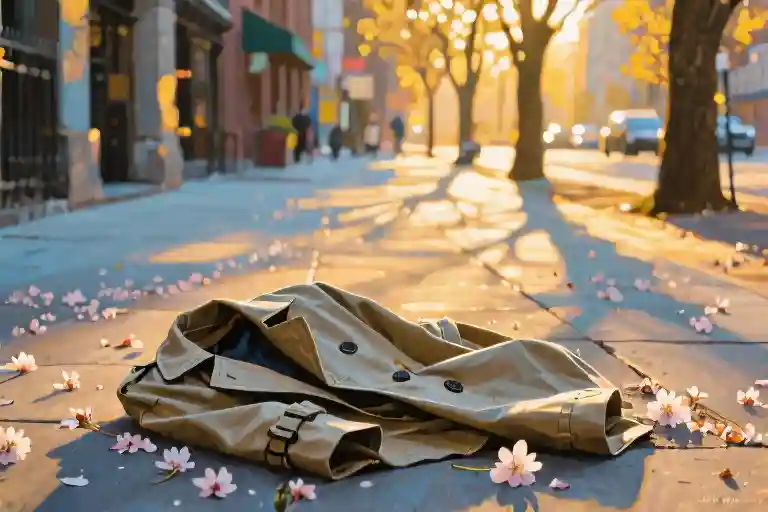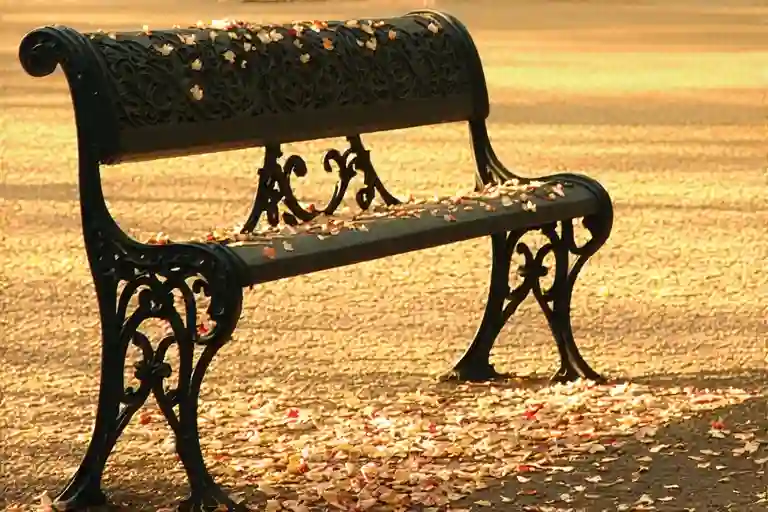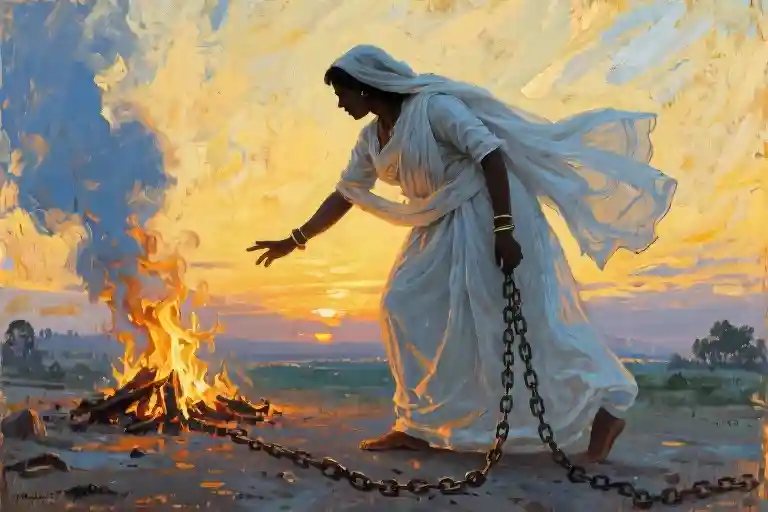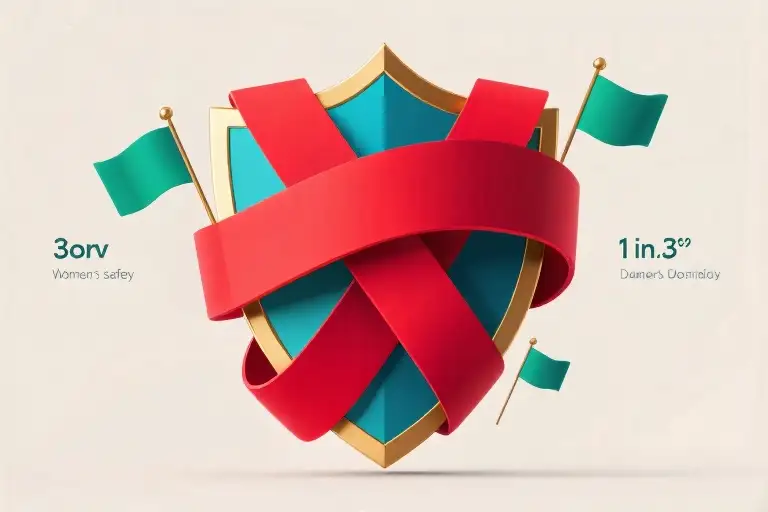The late spring air carried that particular sweetness of blooming trees, the kind that makes you want to inhale deeply and stretch your arms wide. Sunlight filtered through the leaves in sharp, golden shafts – beautiful enough to squint against, warm enough to unbutton your jacket but not quite hot enough to take it off completely. It was one of those rare afternoons where the city’s usual cacophony seemed to dial down a few notches; even the traffic moved with uncharacteristic lethargy, as if the drivers too were distracted by the season’s gentle insistence on joy.
I remember loosening my shoulders as I walked, thinking how perfectly ordinary and yet quietly extraordinary the moment felt. The kind of small urban epiphany that slips by unnoticed most days – sunlight on pavement, the rustle of new leaves, the absence of urgency. For those few blocks, my guard was down in a way it hadn’t been in years.
Until a guy biked past me.
Not around me. Not behind me. Directly at me, close enough that the rush of air from his movement lifted the hem of my trench coat. Close enough that before my conscious mind could process the threat, my body had already reacted – one sharp step backward, fingers instinctively knotting themselves in the coat’s belt loops like anchors. Some ancient part of my brain recognized the pattern before I did: the particular angle of approach, the way his shoulders leaned into the turn, the unoccupied stretch of sidewalk ahead that suddenly felt less like freedom and more like a trap in the making.
Street harassment has a way of turning the most mundane moments inside out. One second you’re admiring cherry blossoms, the next you’re recalculating escape routes with the clinical precision of a military strategist. What struck me later wasn’t just the violation itself (though that would come), but how swiftly the afternoon’s softness evaporated – how thoroughly a single stranger’s actions could rewrite the entire emotional landscape of a day.
The psychological whiplash is its own particular injury. Women learn to carry these abrupt transitions like hidden scars: the way laughter dies in your throat when a car slows beside you, how the pleasure of choosing a flattering outfit gets tempered by strategic considerations of ‘what if.’ We joke about resting bitch faces and pepper spray keychains because the alternative – acknowledging how often we’ve mapped exit strategies from ordinary sidewalks – feels too exhausting to sustain.
That afternoon, with the sun still shining absurdly bright and the trees still doing their beautiful, oblivious blooming, I understood with fresh clarity how street harassment doesn’t just happen in a moment – it colonizes the moments before and after too. The way my hand still clutched my coat long after the biker disappeared around the corner. How I found myself scanning every approaching pedestrian with renewed suspicion. The sour aftertaste left on what should have been an unremarkable, perfectly lovely walk home.
The Biker and the Trench Coat
The afternoon sunlight filtered through the blooming trees, casting dappled shadows on the pavement. It was one of those perfect spring days where the air smelled like possibility—warm but not oppressive, busy yet peaceful. I remember adjusting my trench coat as I walked, enjoying the way the fabric swished around my knees with each step. The kind of small pleasure you only notice when your guard is down.
Then the whir of bicycle tires shattered the calm.
My body reacted before my brain could process why. One sharp step backward, shoulders tensing, fingers instinctively clutching the lapels of my coat like armor. The movement pulled the fabric taut across my chest—a subconscious barrier. Later, I’d realize this was the exact same defensive gesture I’d developed years ago after that other incident on this very street. Muscle memory written in trauma.
The cyclist swerved to block my path, his front wheel cutting diagonally across the sidewalk. He leaned forward, one arm outstretched not to steady himself, but toward me. In that suspended second, a dozen scenarios flashed through my mind: Would he grab my wrist? My waist? The coat I was white-knuckling?
Then came the words, delivered with theatrical curiosity like he’d asked about the weather: “Where are the tits?”
For three heartbeats, the question hung in the air, so absurd it looped back to being frightening. His tone suggested genuine puzzlement, as if my coat—buttoned to the throat against the spring chill—had personally offended him by existing. The cognitive dissonance was almost funny: This man found my lack of visible cleavage more noteworthy than the fact he’d just accosted a stranger in broad daylight.
I felt the old anger rise, that particular blend of fury and exhaustion every woman recognizes. The kind that makes you want to scream but settles instead into a glacial stare—what I’d privately dubbed my “patent bitch glare” after perfecting it through years of unwanted interactions. But this time, something else flickered beneath the rage: a weary amusement at the sheer ridiculousness of it all. Here I was, a grown woman in sensible shoes, being interrogated about my anatomical whereabouts by a man on a Schwinn.
My grip on the coat didn’t loosen. If anything, the wool fabric grew damper under my palms as adrenaline prickled through me. That trench coat became my whole world in that moment—its weight, its texture, the way it created a physical boundary between my body and everything else. I often wonder if harassers realize how many women develop these tiny rituals of protection: the death grip on jacket fronts, the strategic positioning of purses, the calculated routes that add twenty minutes to a commute just to avoid certain streets.
He was still waiting for an answer, head cocked like a confused parrot. The sunlight caught the sweat on his forehead, and I remember thinking how ordinary he looked—no horror-movie leer, no obvious menace beyond the entitlement that made him think this interaction was acceptable. Just some guy who’d decided my walk home was an appropriate time to conduct a breast inventory.
When I didn’t respond (what does one even say to “Where are the tits?”—”In my shirt, where yours should be?” or perhaps “Filed alphabetically between ‘None of your business’ and ‘Get therapy’?”), he shrugged and pedaled away, leaving me standing there clutching my coat like a life preserver. The whole encounter lasted maybe twelve seconds.
Twelve seconds that undid months of my carefully rebuilt confidence. Twelve seconds that sent me right back to square one of vigilance. Twelve seconds to remind me that for women, public space is never truly public—it’s a negotiated territory where we’re always slightly braced for the next interruption, the next violation, the next man who thinks our bodies are community property.
And the trench coat? Still hanging in my closet. Still my favorite. Still something I’ll probably death-grip the next time a stranger decides my anatomy is up for discussion.
Ghosts of the Same Street
That afternoon’s encounter didn’t exist in isolation. The moment that biker blocked my path, his absurd question hanging in the spring air, my body remembered before my mind could catch up. My fingers instinctively clenched the fabric of my trench coat – not because of this stranger specifically, but because of every man who’d ever made me feel like prey on these familiar sidewalks.
Three years earlier, along this same tree-lined stretch where cherry blossoms now drifted onto the pavement, another man on a bicycle had followed me home. For eight blocks, he’d matched my pace, sometimes circling ahead only to double back, his eyes never leaving me. I remember the exact sensation – not fear yet, but that prickling awareness like when you sense a storm coming. The moment I realized he wasn’t just going the same direction, I did what urban women learn to do: changed my route abruptly, ducked into a crowded café, waited twenty minutes before continuing. He was gone when I emerged. ‘Nothing happened,’ I told friends later. Just like with this recent encounter – no physical contact, no overt threats. Just the silent understanding that public space wasn’t equally ours.
But something fundamental shifted after that first incident. My beloved evening walks – those meandering routes where I’d listen to podcasts and watch the city transition from golden hour to twilight – became fraught with calculations. Was it dark enough to risk it? Had too many bars let out? Did I have my keys between my fingers? Eventually, I stopped going altogether. The subway, with its cameras and occasional police presence, felt safer despite the crowds. I developed what I jokingly called my ‘patent bitch glare’ – a perfected combination of resting murder face and thousand-yard stare that made most men instinctively veer away. It worked remarkably well, this unspoken language of urban survival. Too well, perhaps.
What’s chilling isn’t the dramatic changes, but the subtle ones you don’t notice until they’re habitual. The way your shoulders tense when footsteps approach from behind. How you automatically assess escape routes upon entering any space. The mental ledger keeping track of which streets feel safer at different hours. These weren’t conscious choices so much as survival mechanisms accumulating like layers of armor. And the cruel irony? The more effective these tactics became at keeping harassment at bay, the more they reinforced the very isolation that predators rely upon. I stopped being followed because I stopped being accessible – a hollow victory that came at the cost of claiming my own city.
This is the insidious nature of street harassment’s psychological impact. Unlike violent assaults that leave visible scars, these ‘minor’ encounters operate like slow-acting poison. Each incident – whether it’s being followed, catcalled, or cornered with a ridiculous question about anatomy – chips away at your sense of belonging in public spaces. The trauma doesn’t stem from any single event, but from the cumulative realization: your right to exist unbothered is negotiable, and the burden of enforcing that right falls entirely on you. No wonder women develop entire arsenals of avoidance tactics, from the bitch glare to the coat-clutching to the abandoned walking routes. We become experts in making ourselves smaller, less visible, less free – and call it ‘street smarts.’
What my two bicycle encounters, years apart on the same street, revealed wasn’t just personal vulnerability but systemic failure. That first incident taught me to armor up; this recent one proved the armor had become second nature. Both underscored the exhausting truth: as women, our relationship with public space is fundamentally different. We navigate not just physical terrain but an invisible minefield of potential threats, our behavior shaped by experiences men often never notice. And perhaps most damning of all? We’ve internalized this as normal. The real ghost haunting these streets isn’t any individual harasser – it’s the collective resignation that this is simply how things are.
When “Nothing Much” Leaves a Mark
That afternoon with the biker lasted less than thirty seconds. No physical contact occurred, no overt threats were made. By conventional standards, ‘nothing much happened.’ Yet for days afterward, I found myself recalculating walking routes, hesitating before leaving my apartment, reflexively tightening my jacket when passing groups of men. These weren’t conscious choices – they were my nervous system recalibrating what ‘safety’ meant after another breach.
The Myth of ‘Minor’ Harassment
We’ve been conditioned to measure traumatic experiences like ingredients in a recipe – a dash of physical contact here, a tablespoon of explicit threats there. If the mixture doesn’t reach some arbitrary threshold, we’re told to shrug it off. But psychological research on street harassment reveals how this metric fails us. A 2018 study in Psychology of Women Quarterly found that so-called ‘minor’ incidents:
- Trigger the same amygdala activation as more overt threats
- Create cumulative trauma when repeated (which they almost always are)
- Often cause more distress exactly because society dismisses them
That last point stung when I recognized it in myself. The actual encounter with the biker was absurd enough to almost laugh at – it was the subsequent internal monologue that did damage: Maybe I overreacted. It was just words. Other women deal with worse. This mental backpedaling, this erosion of our own lived experience, is how ‘minor’ harassment leaves major scars.
The Ripple Effects
My behavioral changes weren’t unique. In interviews with urban women about their psychological impact of harassment, patterns emerge like urban topography:
- The Shrinking Map – Avoiding certain streets, transit stops, or entire neighborhoods
- The Performance – Developing ‘resting threat face’ or other preemptive defenses
- The Self-Betrayal – Wearing headphones without music to appear ‘unapproachable’
What’s chilling isn’t just that we do these things – it’s that we teach them to each other like survival skills. My ‘patent bitch glare’ was passed down from a college senior; the trench coat clutch came from a Twitter thread. We’ve built entire unspoken curricula around navigating public space safely.
Why ‘Just Ignore It’ Fails
The common advice to ‘brush off’ catcalling misunderstands how memory works. Our brains don’t categorize threats by social acceptability – they note:
- Unexpectedness: A violation of routine (sunny afternoon walks)
- Powerlessness: Inability to control others’ actions toward us
- Ambiguity: Not knowing if this will escalate
These factors make even ‘brief’ encounters stick like burrs. I remember the exact slant of sunlight when that biker blocked my path – not because I chose to, but because adrenaline etched it there.
Reclaiming the Narrative
Breaking this cycle starts with rejecting the ‘minor/major’ hierarchy. Your discomfort isn’t a clerical error to be corrected – it’s data about your environment. When we stop minimizing our own reactions:
- We recognize patterns (that ‘same stretch of road’ phenomenon)
- We validate others’ experiences (#StreetHarassmentStories)
- We redirect accountability (from ‘her sensitivity’ to ‘his actions’)
That last shift is crucial. Notice how we catalog women’s adaptations (tightened jackets, changed commutes) but rarely ask why men’s behavior necessitates them. The real question isn’t ‘Where are the tits?’ – it’s ‘Why do we accept this as normal?’
A Chorus of Tightened Jackets
My story isn’t unique. It’s not even unusual. Across cities and countries, women share this unspoken language of vigilance – the tightened grip on jacket lapels, the strategic detours, the perfected ‘resting threat face’ we deploy like armor. Street harassment operates as a global epidemic with local dialects, where catcalls and invasions of personal space become the background noise of urban life.
Take Sarah from Chicago, who developed tendonitis from perpetually clenching her pepper spray during her commute. Or Priya in London, who still takes 25-minute detours to avoid the construction site where workers once formed a gantlet of lewd comments. These aren’t paranoid fantasies but calculated survival strategies, honed through repetitive experiences most men will never notice. The #StreetHarassmentStories hashtag reveals thousands of such narratives – not dramatic enough for police reports, yet significant enough to alter lives.
What makes these accounts particularly insidious is their cultural normalization. When 85% of women report experiencing street harassment before age 17 (Hollaback! 2018 survey), we’ve moved beyond isolated incidents into systemic socialization. The teenage girl adjusting her school uniform to attract less attention, the jogger wearing headphones to drown out vulgarities – these are all variations of my trench coat clutch, silent testimonies to how public space remains contested territory.
Urban design often exacerbates the problem. Poorly lit alleyways, deserted subway platforms, and pedestrian underpasses become harassment hotspots not by accident but by neglect. Yet solutions exist: Barcelona’s ‘feminist city planning’ incorporates wider sidewalks and transparent bus stops to increase visibility. Tokyo’s women-only train cars, while controversial, acknowledge the reality of commuting risks. These interventions prove environmental changes can disrupt harassment patterns when paired with cultural shifts.
The most pernicious myth suggests enduring street harassment constitutes some feminine rite of passage. But survival shouldn’t be mistaken for acceptance. Every woman who’s ever crossed the street to avoid a group of men, or pretended to take a phone call when walking alone at night, understands this isn’t about oversensitivity – it’s about reading subtle threats with the fluency of necessity.
So next time you see a woman adjusting her grip on her purse or jacket, don’t dismiss it as nervous habit. Recognize it for what it is: a quiet rebellion against spaces that should be safe, a language of self-preservation written in the tension of shoulders and the rhythm of precautionary footsteps. Our tightened jackets tell stories no one should have to narrate.
Where Do We Go From Here?
The phrase “Where are the tits?” still echoes in my mind with unsettling clarity. Not because it was particularly clever or threatening, but precisely because of its absurd randomness. This is the haunting legacy of street harassment – how the most ridiculous encounters can leave lasting imprints on our behavior, our sense of safety, and our relationship with public spaces.
For years after my first harassment incident, I became hyperaware of men on bicycles. I developed what I jokingly called my ‘patent bitch glare’ – a carefully crafted expression meant to broadcast ‘don’t talk to me’ energy before any interaction could begin. I stopped taking evening walks, the very activity that used to bring me peace. My trench coat became both armor and security blanket, its fabric permanently creased from my nervous clutching.
What’s perhaps most frustrating is how these small behavioral changes accumulate silently. There’s no dramatic before-and-after moment with street harassment, just a gradual erosion of comfort in spaces we’re supposed to share equally. The psychological impact of these ‘minor’ incidents functions like water damage – you don’t notice the slow drip until the structure weakens.
This isn’t about individual bad actors. It’s about how our urban environments systematically fail women and marginalized groups. Notice how many women:
- Alter their walking routes to avoid certain areas
- Carry keys between their fingers as makeshift weapons
- Pretend to be on phone calls during solo commutes
- Wear headphones without playing music to monitor surroundings
These aren’t paranoid fantasies but learned survival strategies. When we talk about women’s safety in public, we’re not asking for special treatment – just the basic freedom to exist without developing defensive reflexes as second nature.
So here’s my challenge to readers: The next time you see a woman tightening her grip on her jacket, or crossing the street abruptly, or deploying that thousand-yard stare – pause. Ask yourself what experiences led to that instinct. Better yet, when you witness street harassment happening, consider intervening safely. Small actions create cultural shifts.
Because ultimately, the question shouldn’t be “Where are the tits?” but “Where is our collective responsibility?” The answer is all around us – in every uncomfortable conversation we start, every behavior we refuse to normalize, and every public space we reclaim through simple, unwavering presence.





